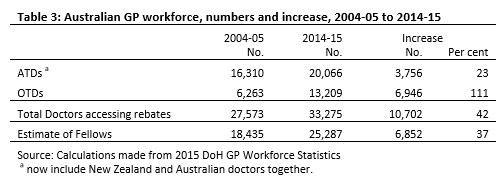The political war over 457 visas has ramped-up after it was revealed that Labor allowed the expansion of the scheme to permit fast food chains like McDonald’s, KFC and Hungry Jacks to employ temporary “skilled” foreign workers to flip burgers in places of high youth unemployment. From The Daily Telegraph:
The flood of foreign visas during Opposition leader Bill Shorten’s time as workplace minister in the Gillard government also extended the program to 650 so-called professions including union officials and goat herders…
In one of the little-known labour agreements approved by Labor in 2012, McDonald’s was given sponsor rights to bring in 285 foreign workers. Hungry Jack’s hired at least 74 people on 457s, KFC brought in 88 foreign workers, while other lesser-known fast food outlets hired 32.
The Opposition leader’s claims that the high number of 457 visas during Labor’s time in office was due to the mining boom, have been undermined by figures showing that many of the McDonald’s jobs filled by foreign workers were in Sydney and even Canberra, which had one of the highest youth unemployment rates in the country.
Figures from between 2010 and 2013 reveal that a third of the overall number of 457 visas across all categories granted were for jobs in Sydney rather than mining areas…
One Nation’s Pauline Hanson has hit-out at Labor, labelling them hypocritical for presiding over the massive 457 visa expansion while today arguing for an “Australia First” policy towards jobs. From The Australian:
“I think it stinks,” she told the Seven network.
“There was about 126,000 that they brought in under Labor. It has gone down to just under 100,000 under the Coalition but still too many.
“There are still too many Australians who need these jobs.”Fellow crossbench Senator Derryn Hinch said “the universe [had] flipped an egg” on Bill Shorten’s face this morning, and that while there may be a need to bring people in on 457 visas to fill skill shortages, jobs at fast food outlets clearly did not qualify.
Meanwhile, Nationals leader Barnaby Joyce has defended the 457 visa scheme, arguing that it is critical for regional Australia. From The Guardian:
Barnaby Joyce has delivered a strong defence of the 457 visa program and its importance to regional Australia, saying temporary workers are essential to fill demand for jobs such as doctors and meatworkers.
“The first thing that all Australians would love in their town is an Australian doctor,” Joyce wrote.
“And if they can’t get an Australian doctor, the next best thing is a foreign doctor. It’s a real worry for people in regional Australia that if you or your child gets sick, there simply is no doctor there…
“The only way we can attract people to many of these towns is if the business structure is complete and furnished with all the right skills at all the right levels,” Joyce said.
“And foreign workers are often necessary for that. People in regional towns expect that. There is no animosity.”
The problem with Joyce’s argument is that the overwhelming majority of 457 visas are not being issued to workers in regional areas, but rather to the big cities of Melbourne and Sydney. Moreover, many of these 457 visa holders are working in professions that are not particularly “skilled”, in short supply, or critical to the economy, such as cooks/chefs, cafe/restaurant staff, and customer service (see next table).
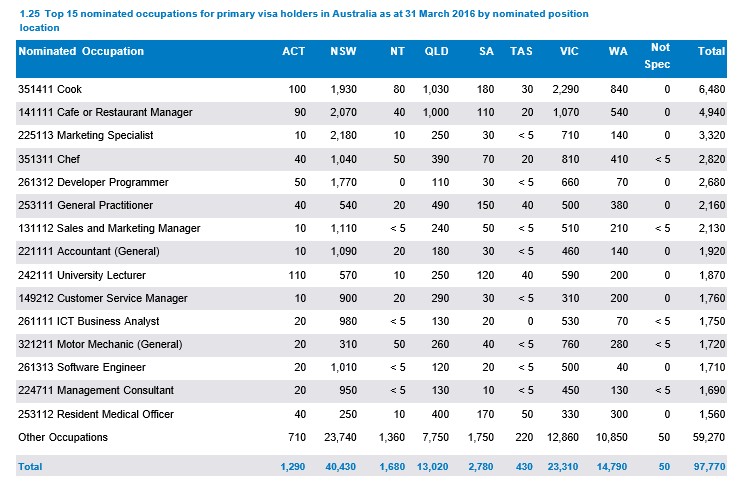
Even with medical doctors there is a lot of rorting going on. I wrote recently how there has been a flood of overseas-trained doctors (OTDs) into Australia over the past decade, whose numbers have ballooned-out by a whopping 111%:
And that these OTDs have driven a 47% rise in the total number of doctors in the decade to 2014-15, around 2.5 times the 19% growth in the Australian population.
Moreover, most of these OTDs are practicing in over-supplied metropolitan (RA 1) areas, not areas of perceived shortage in the regions (RA 2-5):
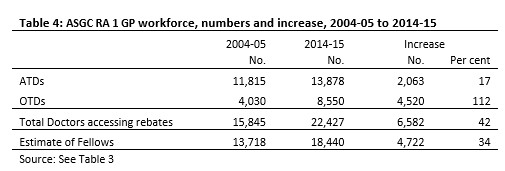
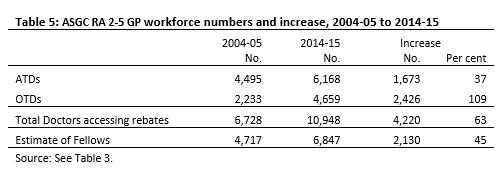
And they are largely responsible for the blow-out in Medicare rebates:
The OTDs influx is therefore responsible for most of the growing oversupply of GPs in RA 1 locations. They are also responsible for most of the increase in Medicare service costs. By June 2015, for all of Australia, OTDs made up 39.7 per cent of the workforce but received 49.8 per cent of total rebates. In RA 1 areas they made up 38.1 per cent of the total workforce and received 47.6 per cent of services paid for by Medicare.
The consequences of which are a continued blow-out in bulk-billed GP visits and Medicare funding costs.
Our politicians need to face the reality that Australia’s visa system is being rorted and take corrective policy action to reform it.
The recent Senate Report entitled A National Disgrace: The Exploitation of Temporary Work Visa Holders found that 457 visas were “not sufficiently responsive either to higher levels of unemployment, or to labour market changes in specific skilled occupations”. It also identified massive flaws in the Consolidated Sponsored Occupations List, which it saw as ad hoc and ineffective. Accordingly, the report recommended implementation of more rigorous, independent, evidence-based, and transparent processes for determining the List, along with more stringent labour market testing.
Joanna Howe, Senior Lecturer in Law at University of Adelaide, has identified similar shortfalls in the 457 visa system:
The mechanism for identifying who can apply for these [457] visas is the Consolidated Sponsored Occupations List. This is a list that has no requirement that the occupation be in demand in the Australian labour market. It includes more than 600 occupations, most of which are not in shortage. So long as an employer nominates an overseas worker to perform a job on this list, then the occupation is deemed to be in need.
Nursing, teaching, engineering and law are all on this list, and are also occupations where Australian graduates are struggling to enter the labour market.
This means the 457 visa can be used by employers who wish to access foreign labour for an ulterior motive.
Meanwhile, it was revealed last week that government officials have refused to cull the Skilled Occupation List because they don’t want Australians to think 457 visas are being used to manage any short-term shortage of workers, despite this being their initial purpose.
While the rorting of “skilled” 457 visas is bad, it is even worse for foreign workers on student visas. These workers were “consistently reported to suffer widespread exploitation in the Australian workforce” according to the above Senate Report, whereas undocumented foreign workers were found to be eroding labour standards for Australian employees:
The committee received evidence that undocumented work by migrant labour has resulted not only in the severe exploitation of highly vulnerable workers, but also impacted Australia’s labour markets, including placing downward pressure on the wages and conditions of Australian workers and undercutting the majority of legitimate employers that abide by Australian workplace laws.
And in a case of Groundhog Day, Fairfax’s Adele Ferguson identified (for the umpteenth time) more wages fraud involving foreign workers over the weekend, this time involving Caltex.
The sad reality is that Australia’s foreign worker visa farce has dragged on far too long at a time when the youth labour market has deteriorated badly:
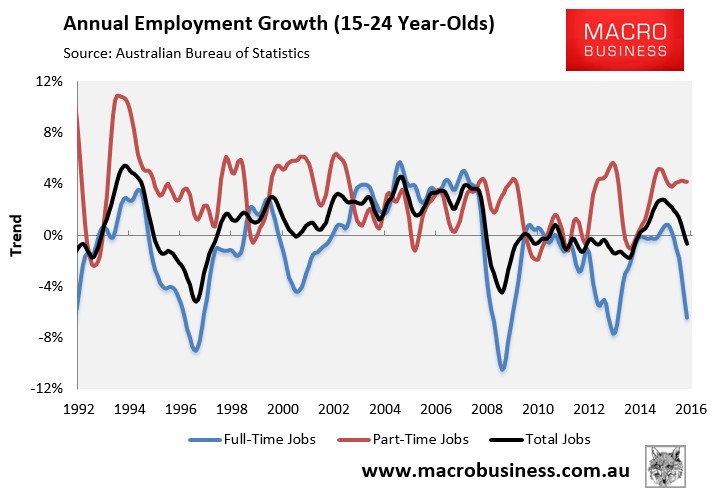
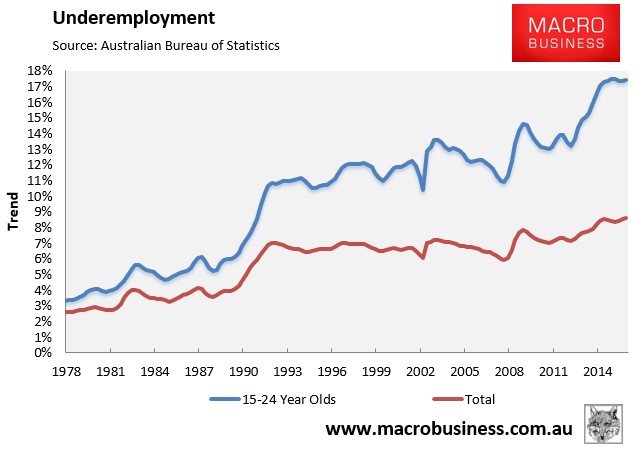
It’s time for fundamental reform of the system.

